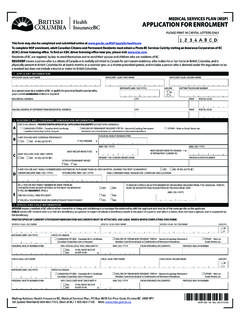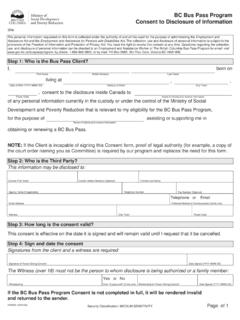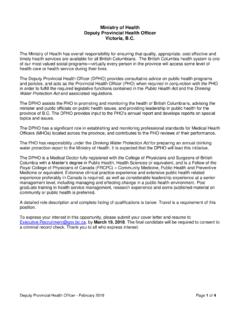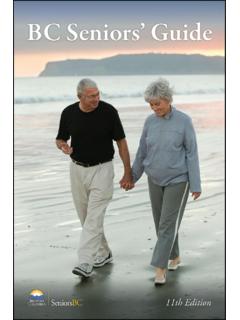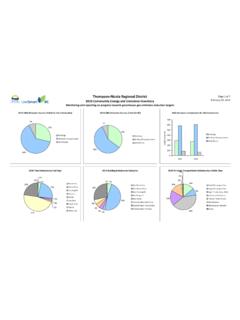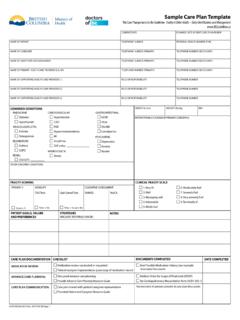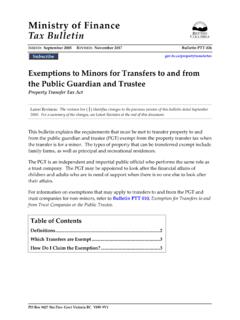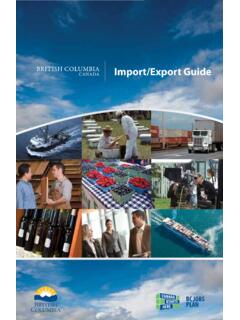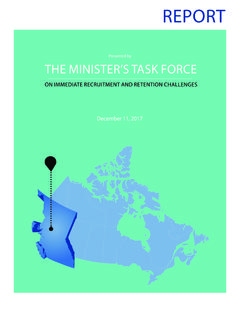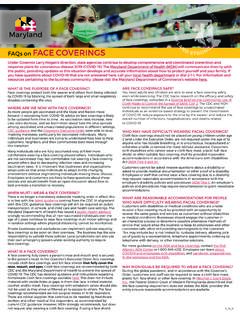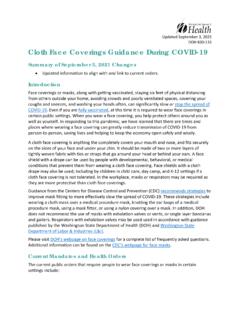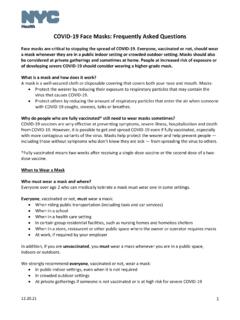Transcription of FACE COVERINGS (COVID-19) December 3, 2021
1 1 ORDER OF THE PROVINCIAL HEALTH OFFICER (Pursuant to Sections 30, 31, 32, 39 (3), 53, 54 (1) (h), 67 (2) and 69 Public Health Act, 2008) FACE COVERINGS (COVID-19) December 3, 2021 The Public Health Act is at: (excerpts enclosed) TO: BRITISH COLUMBIANS AND VISITORS TO BRITISH COLUMBIA WHEREAS: A. On March 17, 2020 I provided notice under section 52 (2) of the Public Health Act that the transmission of the infectious agent SARS-CoV-2, which has caused cases, clusters and outbreaks of a serious communicable disease known as COVID-19 among the population of the Province of British Columbia, constitutes a regional event, as defined in section 51 of the Public Health Act; B. A person infected with SARS-CoV-2 can infect other people with whom the infected person is in contact; C. Vaccination is safe, highly effective, and the single most important preventive measure a person can take to protect themselves, their families, and other persons with whom they come into contact from infection, severe illness and possible death from COVID-19.
2 In particular: (a) the vaccines available in British Columbia are highly effective, providing strong protection across all eligible age groups against infection and especially against severe illness; (b) most British Columbians have strong and durable protection from SARS-CoV-2 resulting from the extended interval between dose one and dose two that is being utilized in British Columbia; (c) a full course of vaccine provides more effective and durable protection against infection and severe illness than natural immunity from prior COVID-19 infection alone, or natural immunity in combination with a single-dose of vaccine; and (d) a full course of vaccine provides highly effective and durable protection from infection Ministry of Health Office of the 4th Floor, 1515 Blanshard Street Provincial Health Officer PO Box 9648 STN PROV GOVT Victoria BC V8W 9P4 Tel: (250) 952-1330 Fax: (250) 952-1570 2 and in particular from severe illness resulting in hospitalization or death from the Delta variant with COVID-19, with illness being mostly milder in vaccinated people who become infected than in unvaccinated people.
3 D. Vaccines, which prevent or reduce the risk of infection with SARS-CoV-2, have been and continue to be readily available in British Columbia and while substantial progress has been made in vaccinating the population of British Columbia 12 years of age and older, a portion of the public remains unvaccinated and there are communities where vaccination rates are low; E. Communities with low vaccination rates have experienced rapid spread of SARS-CoV-2, causing serious illness and increases in hospitalizations and intensive care admissions, primarily in unvaccinated people. By contrast, communities with high vaccination rates have seen corresponding lower transmission, case rates; F. Unvaccinated people are at a significantly greater risk than vaccinated people of being infected with SARS-CoV-2, and those who are infected, experience significantly higher rates of hospitalization, ICU-level care and invasive mechanical ventilation, complications and death when compared with vaccinated people.
4 Unvaccinated people are also at higher risk of transmitting SARS-CoV-2 to other people, including vaccinated people; G. People who are vaccinated can be infected with SARS-CoV-2, but experience less severity of illness than unvaccinated people, especially in younger populations. Vaccinated persons who contract COVID-19 can transmit SARS-CoV-2 but are also generally contagious for shorter periods of time, are less symptomatic, and are less likely to transmit SARS-CoV-2, when compared to unvaccinated infected persons; H. This situation has been exacerbated by the highly transmissible Delta variant of SARS-CoV-2, which is now the dominant variant of SARS-CoV-2 circulating in British Columbia, causing significantly more rapid transmission and increased severity of illness, particularly in younger unvaccinated people. Absent vaccination, British Columbia would be in a far more challenging situation than the fragile balance our current immunization rates have provided, but the transmissibility of the Delta variant means that higher vaccination rates than previously expected are now required to maintain this balance, control transmission, reduce case numbers and serious outcomes, and reduce the burden on the healthcare system, particularly hospital and intensive care admissions; I.
5 The recent appearance of Omicron, a new variant of concern which the World Health Organization has said could lead to surges of infection, underlines the importance of vaccination in protecting public health removing the conditions which foster the development of variants which pose ever greater threats to public health. J. Preserving the ability of the public health and health care systems to protect and care for the health needs of the population, including providing care for health needs other than COVID-19, is critical. High incidence of transmission and illness in one or more regions have spill-over effects on health care delivery across the Province, including in critical care and surgical services. Our public health and health care systems are currently experiencing severe stress, 3 and are stretched beyond capacity in their efforts to prevent and respond to illness resulting from the transmission of COVID-19 in the population, primarily among unvaccinated people; K.
6 Both the public health and the health care systems are using disproportionate amounts of their resources in their efforts to prevent and respond to the transmission of SARS-CoV2, and to provide care for those who become ill with COVID-19, primarily unvaccinated people who comprise the majority of hospitalizations and ICU admissions; L. While people who have contracted SARS-CoV-2 may develop some natural immunity for a period of time following infection, the strength and duration of that immunity varies depending on a multitude of factors, including severity of infection. The risk of reinfection and hospitalization is significantly higher in people who remained unvaccinated after contracting SARS-CoV-2 than in those who were vaccinated post-infection. Vaccination, even after infection, remains an important measure to protect against reinfection. It does so by providing a stronger immune response that is known to be effective for a longer period of time and against a wider variety of strains of SARS-CoV-2 that are currently circulation in British Columbia, including the Delta variant; M.
7 Unvaccinated people in close contact with other people can promote the transmission of SARS-CoV-2 and increase the number of people who develop COVID-19 and become seriously ill; N. During cooler and wetter weather people gather indoors which facilitates and accelerates the transmission of SARS-CoV-2; O. Singing, chanting and reading can propel infected material significant distances and increase the risk of the transmission of SARS-CoV-2, particularly among a group of people who are in close contact with one another in an inside place over a period of time; P. Properly worn, face COVERINGS are one measure that has been shown to suppress the transmission of the SARS-CoV-2 virus and to reduce the risk of contracting COVID-19 in both the vaccinated and the unvaccinated. The non-wearing of masks by people gathering indoors, some of whom might be infected and some of whom might be susceptible to infection, interferes with the suppression of the SARS-CoV-2 virus; Q. I recognize the effect of the measures I am putting in place to protect the health of the residents of BC and, with this in mind, have engaged and will continue to engage in a process of reconsideration of these measures, based upon the information and evidence available to me, including infection rates, sources of transmission, the presence of clusters and outbreaks, particularly in facilities, the number of people in hospital and in intensive care, deaths, the emergence of and risks posed by virus variants of concern, vaccine availability, immunization rates, the vulnerability of particular populations and reports from the rest of Canada and other jurisdictions, with a view to balancing the interests of the people affected by the Order, including constitutionally protected interests, against the risk of harm to residents of BC created by the presence of unvaccinated persons in BC; R.
8 I further recognize that constitutionally-protected interests include the rights and freedoms 4 guaranteed by the Canadian Charter of Rights and Freedoms. These rights and freedoms are not, however, absolute and are subject to reasonable limits, prescribed by law as can be demonstrably justified in a free and democratic society. These limits include proportionate, precautionary and evidence-based restrictions to prevent loss of life, serious illness and disruption of our health system and society. When exercising my powers to protect the health of the public from the risks posed by COVID-19, I am aware of my obligation to choose measures that limit the Charter rights and freedoms of British Columbians less intrusively, where doing so is consistent with public health principles; S. In addition, I recognize the interests protected by the Human Rights Code and have taken these into consideration when exercising my powers to protect the health of the public from the risks posed by COVID-19; T.
9 I am also mindful that the volume of requests for reconsideration of my Orders, and the time and expertise which considering them entails, has become beyond my capacity and that of my office and team of medical health officers to manage, and is using resources which are better directed at assessing and responding to the protection of the public as a whole; U. I have reason to believe and do believe that (a) the presence of the public, operators, workers, school staff persons and students, post-secondary staff persons and students, participants in worship services and events in indoor settings where they intermingle with each other without wearing a face covering a constitutes a health hazard under the Public Health Act; (b) in order to mitigate the risk of the transmission of SARS-CoV-2 arising from the presence of the public, operators and workers, school staff persons and students, post-secondary staff persons and students, participants in worship services and events in indoor settings where they intermingle without wearing a face covering , it is necessary for me to exercise the powers in sections 30, 31, 32, 39, 53, 54, and 67 (2) of the Public Health Act TO ORDER as follows: THIS ORDER REPLACES MY ORDER MADE ON OCTOBER 29, 2021 WITH RESPECT TO FACE COVERINGS IN INDOOR PUBLIC SPACES.
10 Definitions 1 In this order: classroom means an inside area in which a school or, post-secondary institution provides instruction in an educational or training program; face covering means either of the following that covers the nose and mouth of a person: (a) a medical or non-medical mask; (b) a tightly woven fabric; but does not include a small or large clear plastic face shield 5 fitness facility means a place used for fitness activities, including a fitness studio, dance studio or gym, except a gym in a school space or a post-secondary space,; high intensity physical activity means an activity involving sustained increased respiration rates and elevated heart rates; hotel includes a motel, inn, bed and breakfast, hostel or other place in which rooms are maintained for the accommodation of the public; indoor public space means the indoor area of any of the following but does not include a working area (a) a building or structure that is provided for the common use of all occupants and invitees of the building or structure, including lobbies, hallways, public bathrooms and elevators, that is used as (i) a retail business, (ii) a service business, (iii) an office building other than office, cubicle or other room in an office building to which a member of the public has been invited by an operator or worker for the purpose of receiving a service.
